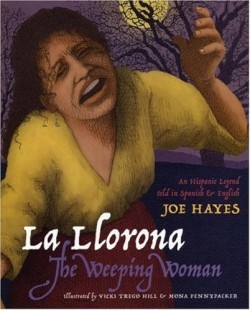La Llorona
The Weeping Woman
“When it grows dark, get inside the house,” warn believers in the legend of La Llorona to their kids. “La Llorona may be about, looking for her children.” Parents fear that this desperate ghost may snatch any child she finds.
A well-known Hispanic legend, which many people believe to be true, tells about a ghost called La Llorona. “La” means “the,” and “llorona” refers to someone who cries. In this version of the legend, Mara, the future ghost, is arrogant and tricks the man of her dreams into marrying her. They live together happily with their two children until Maras husband loses interest in her. Mara dies after making a tragic mistake.
As a child in Arizona with Mexican-American friends, the author learned Spanish and heard this legend many times. He is now a professional bilingual storyteller and has authored numerous juvenile books, largely related to the southwestern United States, Hispanic culture, and Native American culture. His books have won awards including an Aesop Accolade Award and the Arizona Young Readers Award.
The illustrators are mother and daughter. Hill, who operates a book design studio and is the main designer for Cinco Puntos Press, illustrated one of Hayess earlier books, Watch Out for Clever Women, and made duotone illustrations for the original edition of La Llorona. This new edition has four-color illustrations by Pennypacker, who is an art director for Good Hand Arts, a website selling handmade goods. She also illustrated a previous Hayes book, Ghost Fever.
Here, one illustration shows Mara, her serape covering her blouse as she stands beside her small son, holding his hand. Small village houses along a dirt road appear in the background. The facing page depicts Maras husband holding a smaller child.
During a walk with her children, Mara sees her husband in a carriage with an elegant woman. He speaks to the children but ignores Mara. Hayes describes Maras misplaced emotion: “When she saw that, a terrible rage filled Mara, and it all turned against her children.”
The introduction effectively informs readers of the importance of folktales and legends in the Hispanic culture, and the attractive illustrations acquaint children with traditional Mexican clothing and villages. The text encourages bilingualism for both Spanish- and English-speaking children. In spite of the picture-book format, the story tells of tragic events. Although Hayes reports that some younger children have already heard the legend from their families, this book may be better handled by readers age nine and older.
As readers hear the wind howl on a dark night, they may wonder if it could be La Llorona.
Reviewed by
Norma D. Kellam
Disclosure: This article is not an endorsement, but a review. The publisher of this book provided free copies of the book to have their book reviewed by a professional reviewer. No fee was paid by the publisher for this review. Foreword Reviews only recommends books that we love. Foreword Magazine, Inc. is disclosing this in accordance with the Federal Trade Commission’s 16 CFR, Part 255.

